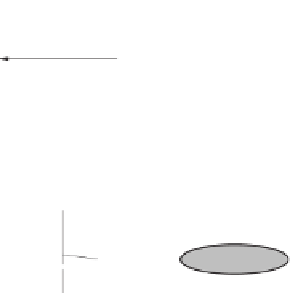Environmental Engineering Reference
In-Depth Information
TABLE 4.1 Radii of gyration for some simple uniform objects. In all cases the rotation
axis is through the centre of mass. For the bar the axis is perpendicular to the bar. For the
disc and the ring the axis is perpendicular to the plane in which the mass lies as shown in
(c)and(d)ofFigure4.5.
Shape
k
Cylindrical shell (or thin ring) of radius
RR
l
2
√
3
Baroflength
l
R
√
2
Disc of radius
R
R
2
5
Solid sphere of radius
R
R
2
3
Spherical shell of radius
R
w
w
l
l
12
Ml
2
1
I
=
1
3
Ml
2
I
=
(a)
(b)
w
w
R
R
=
MR
2
1
2
MR
2
I
I
=
(c)
(d)
Figure 4.5 Moments of inertia for some simple uniform objects for rotation about the axes
shown. (a) and (b) correspond to thin rods, (c) is a thin circular ring and (d) is a flat circular
disc.
Solution 4.3.3
The mass is given in terms of the nucleon mass and is
10
−
27
kg
10
−
25
kg
.
=
×
×
=
×
M
150
1
.
66
2
.
49
We do not know the detailed shape of the nucleus so we will approximate it by a
sphere and use the radius of gyration quoted in Table 4.1, i.e.
2
5
MR
2
2
5
×
10
−
25
10
−
30
kg m
2
10
−
54
kg m
2
.
I
=
=
2
.
49
×
×
41
.
0
×
≈
4
×
























